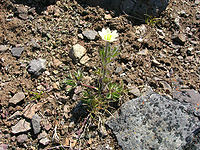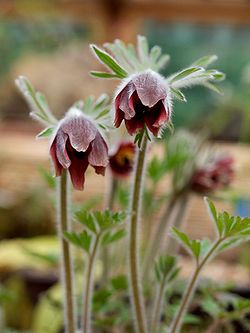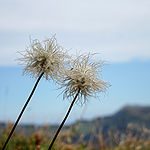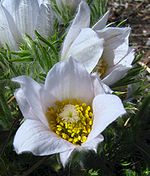Pasqueflower
| Pasqueflower |
|---|

|
| Scientific Classification |
|
| Species |
| Pulsatilla koreana in Korea |
A Pasqueflower is any of the species of flowering plants that belong to the taxonomic genus Pulsatilla. Pasqueflower is commonly called Easter Flower (Anemone pulsatilla), and Wind Flower. The meaning of pasque is "Easter" in old French and also, pasqueflower blooms around Easter days. That is why people called the pasqueflower as Easter flower. [1] There is an American pasqueflower (A. patens), that is similar to European species, which is a bluish, open bell-shaped wildflower. [2] There are 30 species of genus and pulsatilla. In some Middle of the West, and West, people called pasqueflower as prairie smoke. When flower bloomed and the fruits are ripen, the fruits are attached turn silky and feathery. When feathery tails are blown by wind, it looks like the illusion of smoke crossing the prairie. Some native Indians, reported that how they used the pulsatilla. They used it for the halt bleeding and rheumatism. Because Anemone pulsatilla are produced on two stems, so the Dakota Sioux Indians called this plant "twin flowers". [3]
Anatomy
Pasqueflower is a low-growing perennial plant, that is native to prairies of North America, Eurasia and meadows. [4] Pasque flower grows up to 8-12 inches, [5] when pasque flower's growth is done, the stem lengthens and the flower becomes heavy, so they droop downward. In this plant, there are cultivars that provide the color choices, white and reddish-purple. Leaves are mostly grayish-green. [6] Anemone patens is made up with a single flowering stalk, which means it only has one stalk that has flowers, and a few basal leaves.[7] The the buds of this flower, leaves, stem and flowering stalk are covered with silky white hairs. The upper basal leaves have no hair however, the lower leaves have silky hairs. The verticillate leaves are really similar to basal leaves but verticillate leaves are smaller than basal leaves and they are sessile. In whorled leaves, there is a peduncle that have a big flower at the very top of it. During early mid-spring, the pasqueflower blooms until spring is over. The flowers are short-lived and they bloom only sunny and warm day in spring season.[8]
Fruits
Pulsatilla patens make lots of fruits, and their fruits are achenes (small, dry fruit with one seed). The fruits are like linear-ellipsoid and its about 3 mm long and [9].
Leaves
Pulsatilla patens leaves are mainly basal and they are numerous, being long stalked. Mostly, they develop their leaves right after the flowers are bloomed. The blade is approximately 4-10 cm broad, when we anatomize the leaves, there are numerous strong veins. The stem leaves are much smaller and they don't have a stalk. In the middle of the verticil is similar to basal leaves.[10]
Flower
The Pulsatilla patens flower blooms a single flower, lacking petals, but with 5 to 7 colored sepals. Usually, the flower's colors are purple, blue, and very rarely white. The flower is approximately 2.5-3.5 cm long and also there are hairs on the flower. Their main time to bloom flowers is May to August.[11]
Reproduction
When pasqueflower has mature seeds, they starts to detach, collects the seeds and plant seeds. They bloom during the spring or very first week of summer, the flower is usually red, yellow,white, purple or bronze. The germination takes 1-6 months. They are cross-pollinated by bees or flies [12] and Pasqueflower can be reproduced by rhizomes or tubers. They develop their roots each year. [13] The rhizomes are stems that horizontally staying under the ground. Rhizomes are also called root stocks creeping root stocks. If rhizomes are broken into many pieces, they are able to regenerate each pieces. The precess of that is called vegetative reproduction. [14] Tubers are structures that store the nutrients. There are two different types of tubers, root tubers and stem tubers. Both are the methods of asexual reproduction. [15]
Ecology

Pasqueflowers live on the various countries and they are widespread in the tundra, North America, and the mountain meadows up to 10,000 feet. Also in the central and northern Europe and open areas of Russia. They are state flower of South Dakota and provincial flower of Manitoba.[16] They prefer to live in gravelly soils like side of the road, sandy, well-drained areas, and limestone pastures. [17] This plant grows low to the ground to survive in cold climate. The Alpine species needs more than 6 hours of direct sun per day, and moist and well-drained soil. The soil should keep the moist evenly and water regularly. Slugs and Snails are enemy to the Alpine pasqueflower, because they eat everything except woody plants and scented plants. They can eat all stems and leaves. [18]
As the name implies, European pasqueflowers live in Europe. This family of pasqueflower also needs sun, but they can live with little less sun light. They should get the sun light at least for 3 hours. The European pasque flower's flower is smaller than the Alpine species, because they get less sunlight. The soil should be moist and well-drained. The fungi (rust) are the enemy to this plants. Usually, rust appears on leaves, stems and flowers after the winter. The rusts show up as small, bright orange, and yellow, or brown on the leaves. Caterpillars and flea beetles are pest for this family. Caterpillars are fatal to leaves and stems. Flea beetles eat the leaves of the European species. [19]
Use and toxicity of Pasqueflower
Pasqueflower was one of the easiest medicine to get on the prairie in the United States from 1882 to 1918. Most of native Americans used this plant as a medicine for pain of rheumatism and other sickness. Especially, Black foot Indians used it for persuading of abortion to pregnant, [20] and, it was used as ointment, used for sore eyes, and used to boil any pots. Also, in France, pasqueflower has been used traditionally, they used it for coughs and sedative for insomnia. [21] However, pasqueflower is really poisonous if its eaten or when its used as medicine. It has dangerous toxin that affect to our hearts, which are cardiogenic toxins and oxytocin. Pasqueflower can cause irritation, coma, colic, and diarrhea. [22] [23] Specially, for the children and mothers who are pregnant is extremely dangerous if pasque flower's toxin passes through to their body. Pasque flower's toxin is really harmful to women who are pregnant and it affects the baby in mother's womb. Children are vulnerable, because of their curiosity.
The facts about pasque flower
- The Pasque flower mostly live in tundra area
- The Pasque flower is perennial plant that grows up to 1.5 feet long
- The Pasque flower has a few leaves and a single flower with verticil
- Pasque flower's root type is a woody taproot
- The verticillata leaves are really similar to basal leaves but verticillata leaves are smaller than basal leaves and they are sessile
- Stalk, and stem are covered by silky hairs
- Most of native Americans used pasque flower as a medicine for pain of rheumatism and other sickness
- Pasque flower is the State Flower in South Dakota
Video
A video of Pasqueflower
Gallery
Alpine Pasqueflower
(Pulsatilla alpina)
American Pasqueflower
(Pulsatilla patens)
Pulsatilla
(pulsatilla halleri)
Common Pasque flower
(Pulsatilla vulgaris)
References
- Anemone patens) Author. Publisher. Unknown
- Pasque Flower David Beaulieu. Unknown
- Anemone patens (Pulsatilla patens) - Pasque Flower Unknown
- American Pasqueflower Pulsatilla patens (Anemone patens) 2007 eNature.com
- facts about pasqueflower © 2005-2010 Gifting Inc. Apr 20, 2010
- Anemone Ben P. 2001
- Pasque Flower UMC Student Luke Wittkop, Hugo. April 24, 2006
- Pulsatilla 2002-2010 herbs2000.com
- Ranunculaceae Wikipedia
- Video of Pasque Flower Youtube.com








